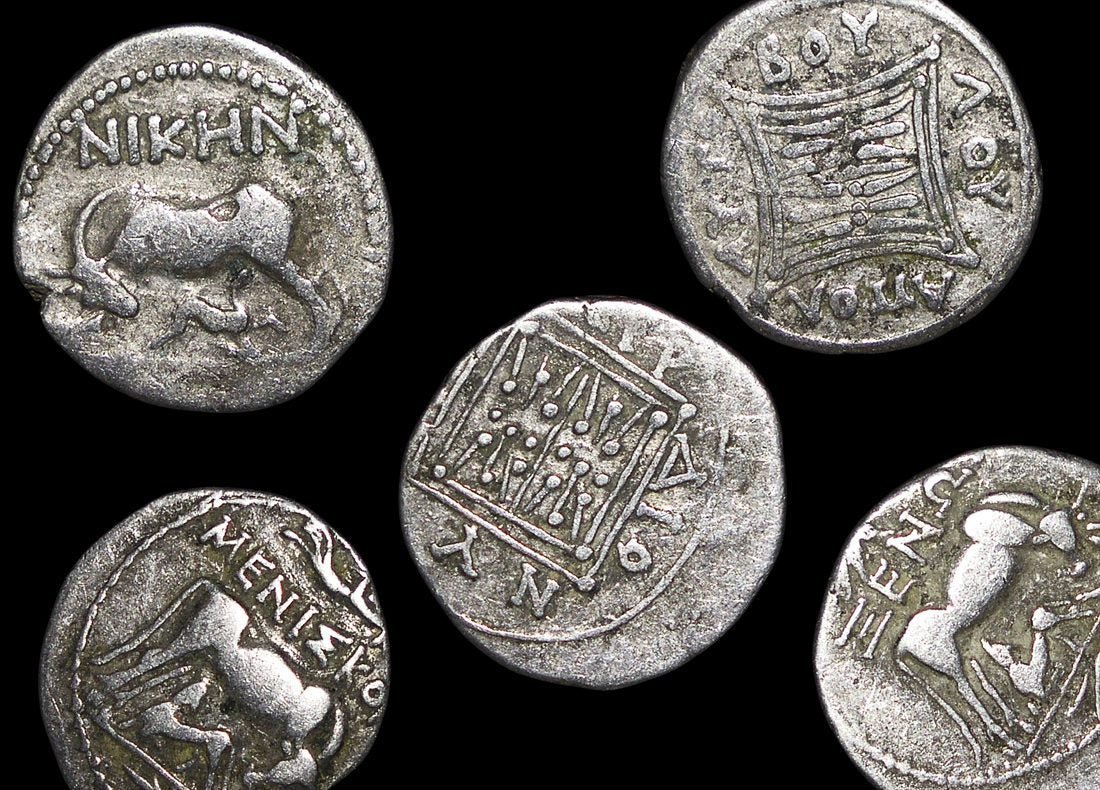 Image 1 of 2
Image 1 of 2

 Image 2 of 2
Image 2 of 2



Macedonian Silver Tetradrachm of Philip III (about 2340-2345 years ago)
This substantial silver coin was minted in Babylon (modern Iraq) shortly after Alexander the Great's death, when his half-brother Philip III Arrhidaeus nominally ruled the vast Macedonian Empire. The tetradrachm was the highest common silver denomination in the Greek world, representing significant purchasing power.
Coin Description:
Front side: Head of Herakles (Hercules) wearing lion-skin headdress facing right, continuing the divine imagery established by Alexander
Back side: Zeus enthroned facing left, holding eagle and scepter; letter "M" in left field; letters "AY" under throne
Technical Details:
Silver composition, weighing 16.80 grams
Tetradrachm denomination (equivalent to four drachms, the highest standard silver coin)
Reference: Price-181
Date: 323-317 BCE
Historical Significance:
Philip III Arrhidaeus was Alexander the Great's half-brother who was declared king after Alexander's sudden death, though real power was exercised by Alexander's generals. This coin was produced at the Eastern capital of Babylon (in modern Iraq) during the beginning of the Wars of the Diadochi (Successors), when Alexander's empire began fragmenting. Continuing Alexander's coin designs helped maintain economic stability during political uncertainty, while the placement letters indicate the specific mint and production series of this important trade coin.
This substantial silver coin was minted in Babylon (modern Iraq) shortly after Alexander the Great's death, when his half-brother Philip III Arrhidaeus nominally ruled the vast Macedonian Empire. The tetradrachm was the highest common silver denomination in the Greek world, representing significant purchasing power.
Coin Description:
Front side: Head of Herakles (Hercules) wearing lion-skin headdress facing right, continuing the divine imagery established by Alexander
Back side: Zeus enthroned facing left, holding eagle and scepter; letter "M" in left field; letters "AY" under throne
Technical Details:
Silver composition, weighing 16.80 grams
Tetradrachm denomination (equivalent to four drachms, the highest standard silver coin)
Reference: Price-181
Date: 323-317 BCE
Historical Significance:
Philip III Arrhidaeus was Alexander the Great's half-brother who was declared king after Alexander's sudden death, though real power was exercised by Alexander's generals. This coin was produced at the Eastern capital of Babylon (in modern Iraq) during the beginning of the Wars of the Diadochi (Successors), when Alexander's empire began fragmenting. Continuing Alexander's coin designs helped maintain economic stability during political uncertainty, while the placement letters indicate the specific mint and production series of this important trade coin.
This substantial silver coin was minted in Babylon (modern Iraq) shortly after Alexander the Great's death, when his half-brother Philip III Arrhidaeus nominally ruled the vast Macedonian Empire. The tetradrachm was the highest common silver denomination in the Greek world, representing significant purchasing power.
Coin Description:
Front side: Head of Herakles (Hercules) wearing lion-skin headdress facing right, continuing the divine imagery established by Alexander
Back side: Zeus enthroned facing left, holding eagle and scepter; letter "M" in left field; letters "AY" under throne
Technical Details:
Silver composition, weighing 16.80 grams
Tetradrachm denomination (equivalent to four drachms, the highest standard silver coin)
Reference: Price-181
Date: 323-317 BCE
Historical Significance:
Philip III Arrhidaeus was Alexander the Great's half-brother who was declared king after Alexander's sudden death, though real power was exercised by Alexander's generals. This coin was produced at the Eastern capital of Babylon (in modern Iraq) during the beginning of the Wars of the Diadochi (Successors), when Alexander's empire began fragmenting. Continuing Alexander's coin designs helped maintain economic stability during political uncertainty, while the placement letters indicate the specific mint and production series of this important trade coin.
Philip III Arrhidaeus (Ancient Greek: Φίλιππος Ἀρριδαῖος, romanized: Phílippos Arrhidaîos; c. 357 BC – 317 BC) was king of the ancient Greek kingdom of Macedonia from 323 until his execution in 317 BC. He was a son of King Philip II of Macedon by Philinna of Larissa, and thus an elder half-brother of Alexander the Great. Named Arrhidaeus at birth, he assumed the name Philip when he ascended to the throne.
As Arrhidaeus grew older it became apparent that he had mild learning difficulties. Plutarch was of the view that he became disabled by means of an attempt on his life by Philip II's wife, Queen Olympias, who wanted to eliminate a possible rival to her son, Alexander, through the employment of pharmaka (drugs/spells); however, most modern authorities doubt the truth of this claim.[1]
Alexander was fond of Arrhidaeus and took him on his campaigns[citation needed], both to protect his life and to prevent his use as a pawn in any prospective challenge for the throne. After Alexander's death in Babylon in 323 BC, the Macedonian army in Asia proclaimed Arrhidaeus as king;[2] however, he served merely as a figurehead and as the pawn of a series of powerful generals.[3]
You Might Also Like










